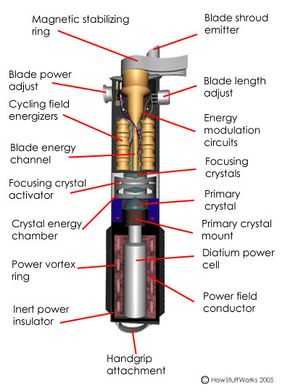Inside the Lightsaber
The art of lightsaber construction, like many things in life, generally passes down by word of mouth from Jedi Knights and Jedi Masters to their young Padawan learners. Oh sure, there are pamphlets and educational films, but there's no substitute for experience when creating a shaft of brilliant plasma. If you don't know a Jedi Master, don't fret: They also manufacture the weapons in China.
Crack open any two lightsaber hilts and the interiors may differ somewhat, but the key features are remarkably consistent across lightsabers. In each, you'll find the major components that follow.
Advertisement
- Much like the average iPhone, lightsabers are powerful devices that require vast amounts of energy. Any device that can melt through a blast door obviously requires access to tremendous energy reserves. The source of this energy is a diatium power cell -- a device no larger than a roll of coins. You've probably noticed these cells at your local grocery store, though you generally have to ask a clerk for access.
- Surrounding the power cell is a power field conductor and the power vortex ring. These two devices work together to move the available energy toward the energy gate, which in turn controls the flow of energy into the crystal energy chamber.
- The crystal energy chamber is the heart of any lightsaber, and the chamber depends on at least two crystals, each with its own specific role. The primary crystal converts the energy from the power cell and transfers it to one or more focusing crystals, held in place by the focusing crystal activator. If these two crystals aren't aligned perfectly, the lightsaber will detonate the moment you activate it -- so never buy a used one from a partially exploded man.
- The energy channel generates the lightsaber blade itself. Energy flows from the crystal energy chamber and then converts into the arc wave that makes up the blade. The arc wave flows up through the blade energy channel and past the cycling field energizers.
- The refined arc wave makes its way to the blade arc tip and from there becomes visible as the glowing blade of the lightsaber that's so familiar. The blade's color depends on your choice in crystal, so be sure to shop around if building your own. Most lightsaberists prefer a traditional blue or red blade, but particularly trendy Jedi have been known to employ a whole rainbow of deadly hues.
So, the next time you slay a snow monster or warm up a cup of coffee with your trusty Jedi melee weapon, take a moment to think about all the technology that makes it possible.
Author's Note: How Lightsabers Work
I grew up with Star Wars and brandished many a flashlight as my own make-believe lightsaber, but it’s one of those fantastic sci-fi inventions that I never stopped loving. I played an unhealthy amount of “Star Wars Jedi Knight II: Jedi Outcast” the summer of 2002, and while I groaned as much as the next fan about the prequel trilogy, the lightsaber duels themselves delivered big time. I even watched a few of them again for this article, and for a good half-hour there I was 8 again, rooting on my favorite Sith Lords. Yeah, I was one of those kids.
"How Lightsabers Work" was one of the first HowStuffWorks articles I read, long before I actually joined the editorial team. So, when the opportunity came up to work with this article and add my own name to the byline, I jumped at the chance. Dozens of new lightsaber styles have entered service since this article initially published, but the "science" still holds up nicely.
